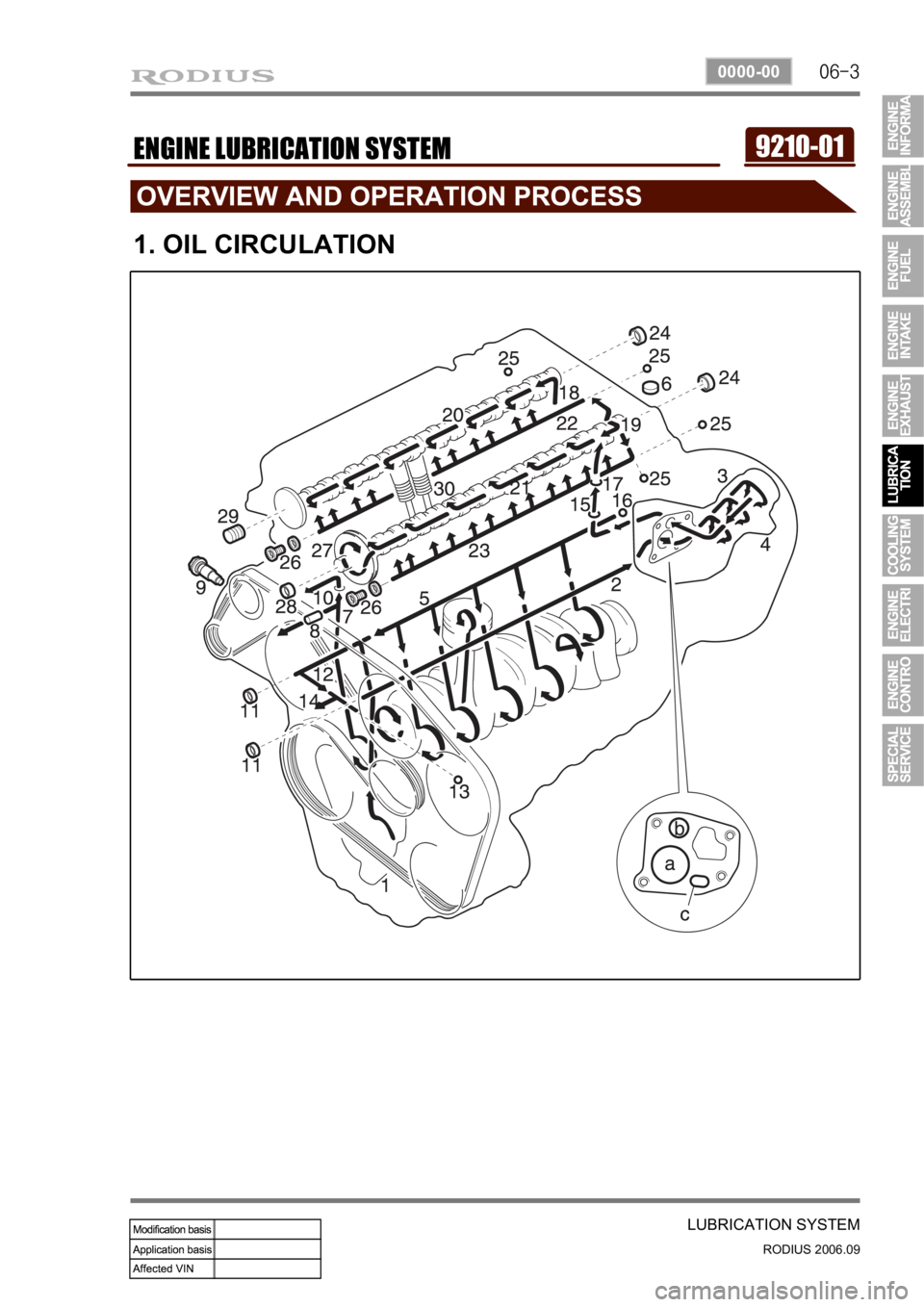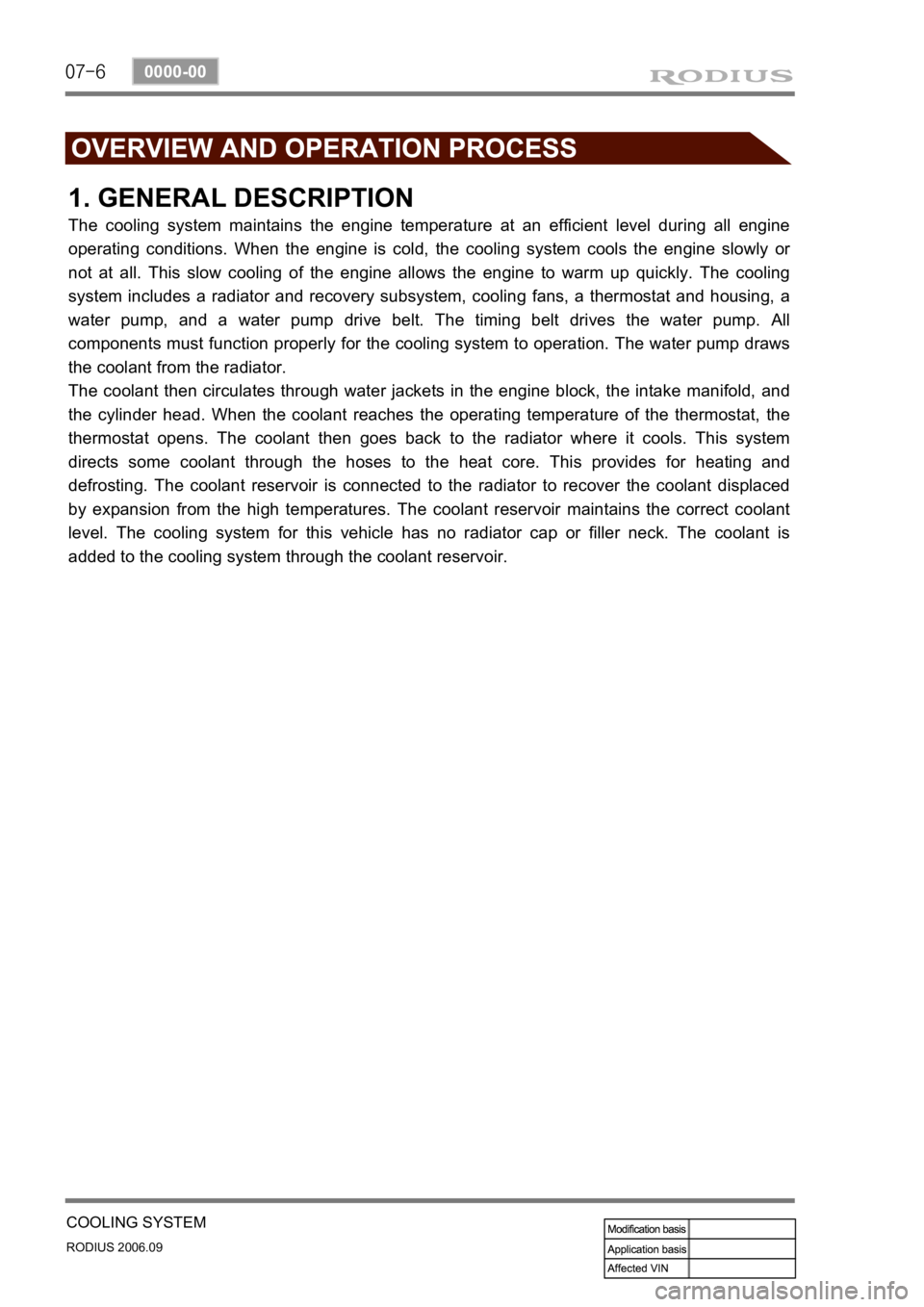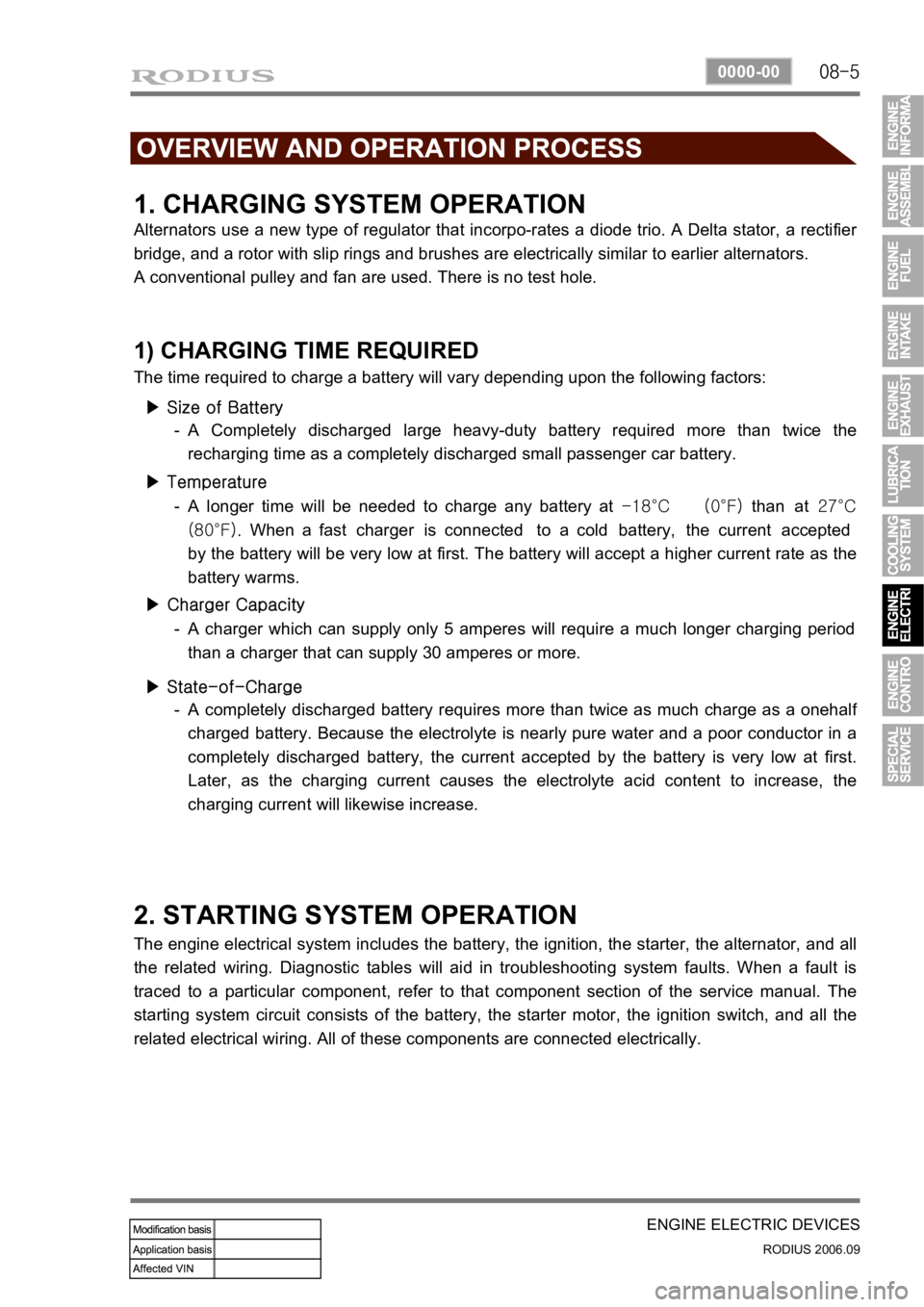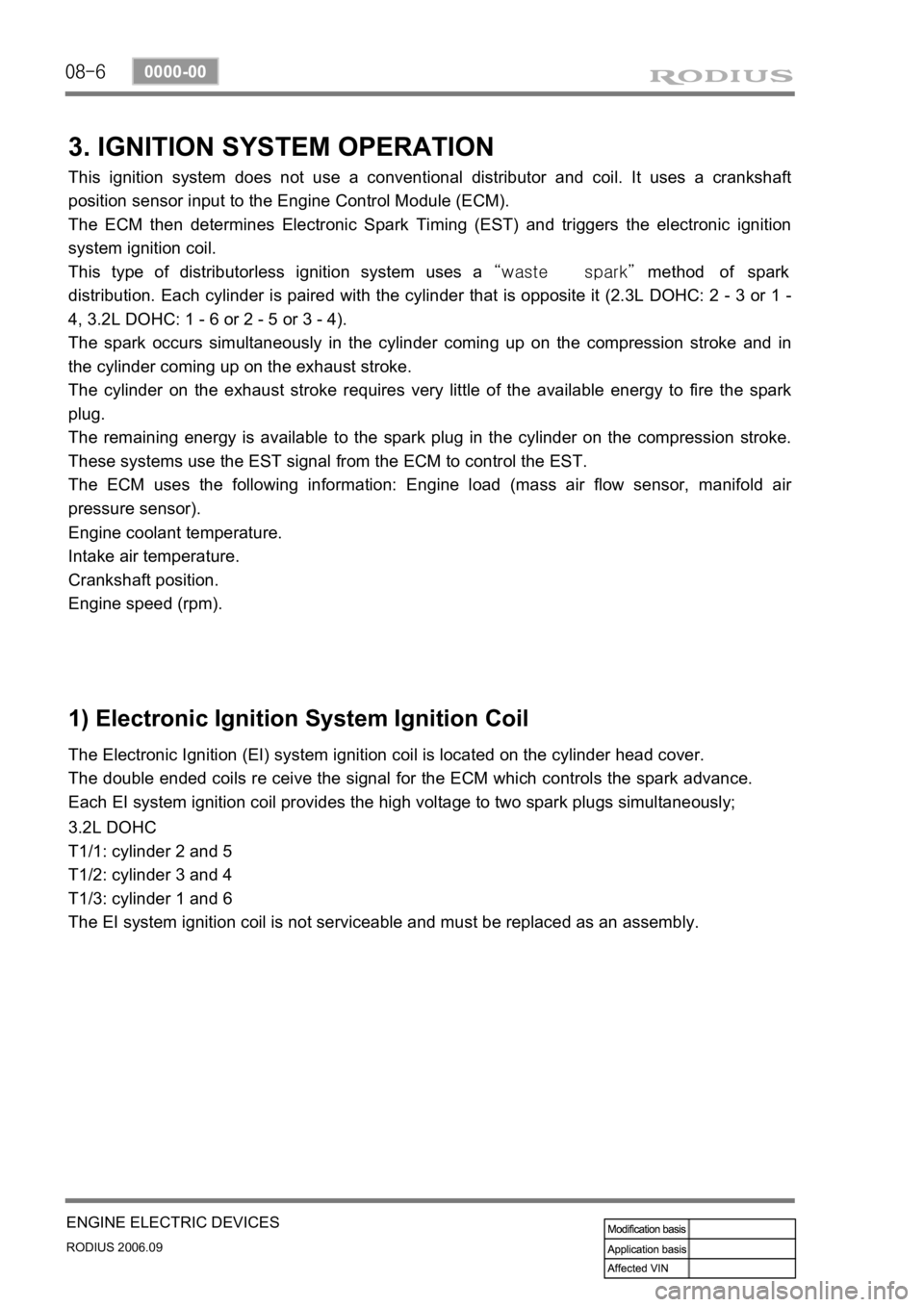engine SSANGYONG RODIUS 2007 Owner's Manual
[x] Cancel search | Manufacturer: SSANGYONG, Model Year: 2007, Model line: RODIUS, Model: SSANGYONG RODIUS 2007Pages: 465, PDF Size: 56.32 MB
Page 68 of 465

03-4
RODIUS 2006.09
0000-00
ENGINE FUEL SYSTEM
temperature vs resistance ▶
Page 70 of 465

05-3
ENGINE EXHAUST SYSTEM
RODIUS 2006.09
0000-00
2420-01ENGINE EXHAUST SYSTEM
1. OVERVIEW OF EXHAUST SYSTEM
When you are inspecting or replacing exhaust system components, make sure there is
adequate clearance from all points on the underbody to avoid possible overheating of the
floor panel and possible damage to the passenger compartment insulation and trim
materials.
Check the complete exhaust system and the nearby body areas and trunk lid for broken,
damaged, missing or mispositioned parts, open seams, holes, loose connections, or othe
r
deterioration which could permit exhaust fumes to seep into the trunk may be an indication
of a problem in one of these areas. Any defects should be corrected immediately. -
2. OVERVIEW OF MUFFLER
Aside from the exhaust manifold connection, the exhaust system uses a flange and seal joint
design rather than a slip joint coupling design with clamp and U-bolts.
If hole, open seams, or any deterioration is discovered upon inspection of the front muffler and
pipe assembly, the complete assembly should be replace, the complete assembly should be
replaced.
The same procedure is applicable to the rear muffler assembly. Heat shields for the front and
rear muffler assembly and catalytic converter protect the vehicle and the environment from the
high temperatures that the exhaust system develops.
3. OVERVIEW OF CATALYTIC CONVERTER
When jacking or lifting the vehicle from the body side rails, be certain that the lift pads do
not contact the catalytic converter, as this could damage the catalytic converter. -
Use of anything other than unleaded fuel will damage the catalyst in the catalytic
converter. -
The catalytic converter are emission-control devices added to the exhaust system to
reduce pollutants from the exhaust pipes.
The oxidation catalyst is coated with a catalytic material containing platinum and
palladium, which reduces levels of hydrocarbon (HC) and carbon monoxide (CO) from
the exhaust gas. The three-way catalyst has coatings which contain platinum and
rhodium, which additionally lower the levels of oxides of nitrogen (NOx). ·
·
Page 71 of 465

05-4
RODIUS 2006.09
0000-00
ENGINE EXHAUST SYSTEM
4. FASTENER TIGHTENING
SPECIFICATIONS
Page 72 of 465

06-3
LUBRICATION SYSTEM
RODIUS 2006.09
0000-00
9210-01ENGINE LUBRICATION SYSTEM
1. OIL CIRCULATION
Page 74 of 465

07-3
COOLING SYSTEM
RODIUS 2006.09
0000-00
2110-01ENGINE COOLING SYSTEM
1. GENERAL SPECIFICATIONS
Page 77 of 465

07-6
RODIUS 2006.09
0000-00
COOLING SYSTEM
1. GENERAL DESCRIPTION
The cooling system maintains the engine temperature at an efficient level during all engine
operating conditions. When the engine is cold, the cooling system cools the engine slowly o
r
not at all. This slow cooling of the engine allows the engine to warm up quickly. The cooling
system includes a radiator and recovery subsystem, cooling fans, a thermostat and housing, a
water pump, and a water pump drive belt. The timing belt drives the water pump.
All
components must function properly for the cooling system to operation. The water pump draws
the coolant from the radiator.
The coolant then circulates through water jackets in the engine block, the intake manifold, and
the cylinder head. When the coolant reaches the operating temperature of the thermostat, the
thermostat opens. The coolant then goes back to the radiator where it cools. This system
directs some coolant through the hoses to the heat core. This provides for heating and
defrosting. The coolant reservoir is connected to the radiator to recover the coolant displaced
by expansion from the high temperatures. The coolant reservoir maintains the correct coolant
level. The cooling system for this vehicle has no radiator cap or filler neck. The coolant is
added to the cooling system through the coolant reservoir.
Page 80 of 465

08-3
ENGINE ELECTRIC DEVICES
RODIUS 2006.09
0000-00
1452-01ENGINE ELECTRIC DEVICES
1. GENERAL SPECIFICATIONS
Page 81 of 465

08-4
RODIUS 2006.09
0000-00
ENGINE ELECTRIC DEVICES
2. FASTENER TIGHTENING SPECIFICATIONS
Page 82 of 465

08-5
ENGINE ELECTRIC DEVICES
RODIUS 2006.09
0000-00
1. CHARGING SYSTEM OPERATION
Alternators use a new type of regulator that incorpo-rates a diode trio. A Delta stator, a rectifier
bridge, and a rotor with slip rings and brushes are electrically similar to earlier alternators.
A conventional pulley and fan are used. There is no test hole.
1) CHARGING TIME REQUIRED
The time required to charge a battery will vary depending upon the following factors:
▶ Size of Battery
A Completely discharged large heavy-duty battery required more than twice the
recharging time as a completely discharged small passenger car battery. -
▶ Temperature
A longer time will be needed to charge any battery at -18°C (0°F) than at 27°C
(80°F). When a fast charger is connected to a cold battery, the current accepted
by the battery will be very low at first. The battery will accept a higher current rate as the
battery warms. -
▶ Charger Capacity
A charger which can supply only 5 amperes will require a much longer charging period
than a charger that can supply 30 amperes or more. -
▶ State-of-Charge
A completely discharged battery requires more than twice as much charge as a onehal
f
charged battery. Because the electrolyte is nearly pure water and a poor conductor in a
completely discharged battery, the current accepted by the battery is very low at first.
Later, as the charging current causes the electrolyte acid content to increase, the
charging current will likewise increase. -
2. STARTING SYSTEM OPERATION
The engine electrical system includes the battery, the ignition, the starter, the alternator, and all
the related wiring. Diagnostic tables will aid in troubleshooting system faults. When a fault is
traced to a particular component, refer to that component section of the service manual. The
starting system circuit consists of the battery, the starter motor, the ignition switch, and all the
related electrical wiring. All of these components are connected electrically.
Page 83 of 465

08-6
RODIUS 2006.09
0000-00
ENGINE ELECTRIC DEVICES
3. IGNITION SYSTEM OPERATION
This ignition system does not use a conventional distributor and coil. It uses a crankshaft
position sensor input to the Engine Control Module (ECM).
The ECM then determines Electronic Spark Timing (EST) and triggers the electronic ignition
system ignition coil.
This type of distributorless ignition system uses a “waste spark” method of spark
distribution. Each cylinder is paired with the cylinder that is opposite it (2.3L DOHC: 2 - 3 or 1 -
4, 3.2L DOHC: 1 - 6 or 2 - 5 or 3 - 4).
The spark occurs simultaneously in the cylinder coming up on the compression stroke and in
the cylinder coming up on the exhaust stroke.
The cylinder on the exhaust stroke requires very little of the available energy to fire the spark
plug.
The remaining energy is available to the spark plug in the cylinder on the compression stroke.
These systems use the EST signal from the ECM to control the EST.
The ECM uses the following information: Engine load (mass air flow sensor, manifold ai
r
pressure sensor).
Engine coolant temperature.
Intake air temperature.
Crankshaft position.
Engine speed (rpm).
1) Electronic Ignition System Ignition Coil
The Electronic Ignition (EI) system ignition coil is located on the cylinder head cover.
The double ended coils re ceive the signal for the ECM which controls the spark advance.
Each EI system ignition coil provides the high voltage to two spark plugs simultaneously;
3.2L DOHC
T1/1: cylinder 2 and 5
T1/2: cylinder 3 and 4
T1/3: cylinder 1 and 6
The EI system ignition coil is not serviceable and must be replaced as an assembly.